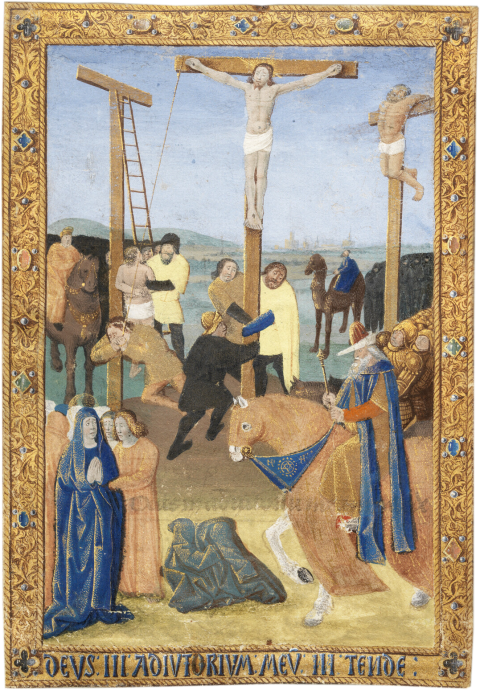


Jean Colombe (1430-1493)
, France, Bourges, c.1470–75Jean Colombe (1430-1493)
Description
This is a splendid example of some of the most accomplished works of Jean Colombe, with a sister leaf from the same manuscript at the Louvre in Paris (see below). The sister miniature illustrating Christ before Pilate (see below) is attributed to Jean Colombe himself by François Avril in Les Enluminures du Louvre: Moyen Âge et Renaissance (exh. cat., Paris, 2011), no 96 (mentioning the present leaf), and Les Manuscrits à peintures en France, 1440–1520 (exh. cat., Paris, 1993), p. 332. The present miniature of the Crucifixion illustrates the hour of Sext from a Book of Hours that must have been richly illuminated with large miniatures for each of the long Hours of the Cross. Originally intended to be smaller the artist has overpainted the opening line of text (“Deus in adiutorium meum intende”) three quarters of the way down the page, expanding the scene to occupy the entire page.
Jean Colombe belonged to a prominent family of artists from Bourges, the chief town of the duchy of Berry. He was recorded there from 1463 until 1493 and, except for a few short periods, he is believed to have lived and worked there continuously. Nonetheless, neither his reputation nor his activity was restricted to his native city: he was patronized and protected by Charlotte of Savoy, queen of Louis XI and a noted bibliophile. He illuminated manuscripts for the queen, her daughter Anne of Beaujeu, and various members of the court. It was probably through Charlotte that Colombe was introduced into the service of her nephew, Charles I, Duke of Savoy, who retained him to complete two unfinished manuscripts in his library: the splendid Apocalypse by Jean Bapteur and Perronet Lamy (Spain, Escorial, E. Vit. 5) and, probably the most celebrated of all Books of Hours, the Limbourg brothers Très Riches Heures of the Duke of Berry.
Colombe was commissioned to illustrate secular as well as religious texts and seems to have taken delight in providing scenes set within complex architecture or expansive landscapes and, wherever possible, containing crowds of onlookers. His narrative enthusiasm and invention were evidently keenly appreciated and, with the aid of his atelier – including his son and grandson – he decorated many manuscripts including some with the most ambitious of illustrative ensembles. This miniature of the Crucifixion displays some of these interests: the rich narrative including the discarded cloaks of the mourners, the thief taken down from the cross, Pilate on horseback, and the crowd of soldiers in the background; and the decorative texture of the jeweled frame also present in the Christ before Pilate miniature.
He brought the same skills and interests to the Books of Hours he illuminated for his most important patrons, most spectacularly in the Hours of Louis de Laval (Paris, BnF, Lat. 920), which was completed, with the help of collaborators and assistants, in separate campaigns between 1470 and 1489: C. Schaefer, “Nouvelles observations au sujet des Heures de Louis de Laval,” Arts de l’Ouest, 1980, pp.33-68; Avril and Reynaud Les manuscrits, pp.328-332.
Provenance:
1. ? John Boykett Jarman (1782–1864): the present miniature was copied by Caleb Wing, but cannot be confidently identified in Jarman’s 1864 auction.
2. Maggs Bros., Cat. 802, 1951, no 15 (ill.), priced £63; inscribed ‘£55’ in pencil on the reverse.
3. Collection of Alfred (1900-1965) and Felicie Amelie (Radziejewski) Scharf (1900-1991), United Kingdom, the former an art historian and scholar on 15th century Italian panel painting and the latter an art historian.
Sister miniature:
Christ Before Pilate (Paris, Musée du Louvre, Département des Arts graphiques, RF 54717; formerly Galerie Les Enluminures, 2008). This is the only sister leaf known, although there must have been a miniature depicting the Flagellation or the Carrying of the Cross between the Louvre miniature and the present one (see Avril for a complete discussion of the sister leaves and hypotheses about the parent manuscript, 2011).
Description and Condition:
ruled for 16 lines, the recto with the end of Terce, from “penam pro salute nostra […],” with a panel border incorporating winged putti, the verso with a full page miniature, comprising Sext in the Hours of the Passion, the reverse inscribed in modern pencil ‘17’ (tiny losses of pigment to the sky and to the face and body of the crucified thief, else in excellent condition). The opening line of text (“Deus in adiutorium meum intende”) was written by the scribe about three-quarters of the way down the page, so the original intention must have been to have a three-quarter page miniature surrounded by a border, but this incipit was overpainted, the space occupied by the miniature to encompass the whole page, including margins, and the overpainted text included in the lower painted frame at the bottom.